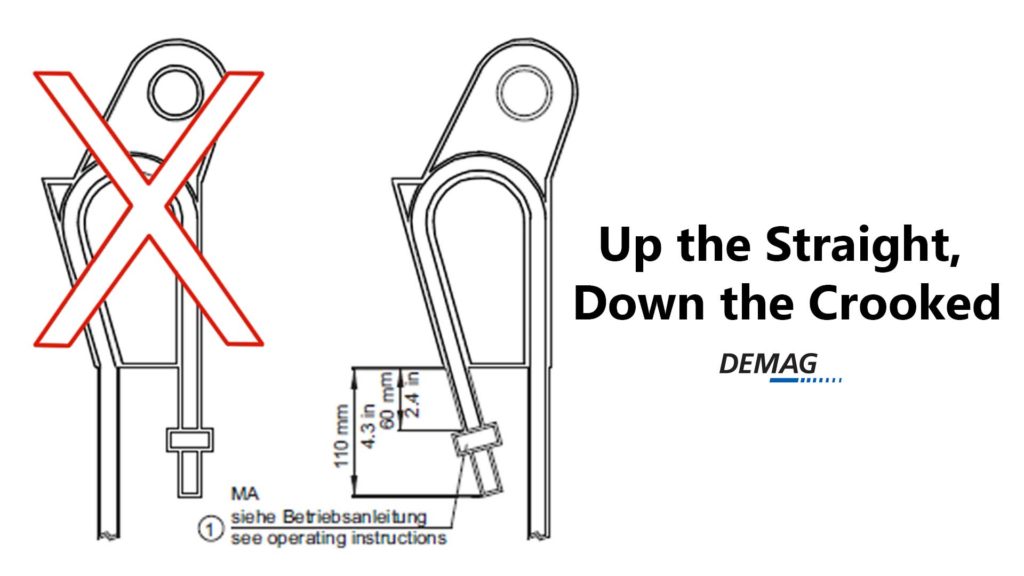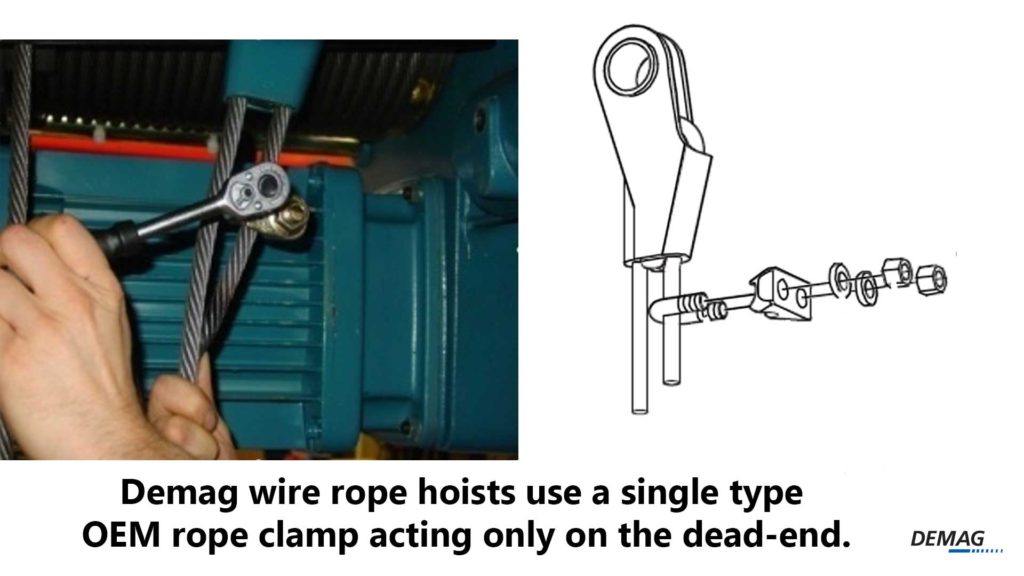If you’ve ever attended a Demag Service Training seminar, you have heard us say, “Up the Straight, Down the Crooked.” When it comes to proper reeving of the dead-end socket on a Demag wire rope hoist, it’s an important statement to remember. In this post, we will talk about the importance of proper reeving in the dead-end socket and the most common deficiencies found during inspections.

For the last 50 years, we have been teaching our students “Up the straight, down the crooked” when they attend our service training seminars and learn about reeving for a dead-end socket. We came up with this statement so it was easy to remember. The live rope on a Demag wire rope hoist is meant to be lined up perpendicular to the mounting pin for the wedge pocket and rolls over the unaligned side of the wedge. The dead-end of the rope should be left hanging out of the pocket about 4-1/2 inches. The single rope clamp should be placed about 2.4 inches below the wedge pocket. After the initial loading to seat the wedge, an airgap should remain between the single rope clamp and the bottom of the wedge pocket. The rope clamp is used during subsequent visual inspections to determine that the rope remains securely in the pocket. A decal is placed close to the dead-end to graphically depict the correct installation.

Wire rope should be inspected frequently, on a monthly basis, and include inspection of the wedge. If you have a double girder crane, inspection of the wedge is a mandatory requirement in the code so never forget to include it in the inspection. If a monthly inspector discovers an installation error with the rope wedge, it should be corrected before the equipment is used again. Periodic inspection is typically conducted on an annual basis and these inspectors should also include the rope and wedge.
Another commonly found installation error is when the inspector finds a double rope clamp has been substituted in place of the original single rope clamp. The OEM rope clamp is a single type and acts only on the dead-end of the wire rope, serving as a safety catch in the event of slippage of the wire rope through the wedge. The Demag design does not attach the dead end of the rope to the live rope. When a double rope clamp is found attaching the dead and live ropes together below the pocket, it means a non-OEM part has been substituted. This creates stress points in unintended locations and the condition should be changed back to the original design by a qualified technician.

In addition, if the inspector sees that the rope clamp is contacting the bottom of the wedge pocket, it indicates insufficient clamping pressure to secure the wire rope, and that the wire rope has slipped through the wedge pocket during use. When this deficiency is found, the hoist should be locked out for use until a qualified technician can be brought in to fix the issue.
When you’re performing your regular inspections on your Demag wire rope hoists, inspection of the wire rope and related hardware is critical. Always perform inspections and maintenance at regular intervals. We have given our Demag trained technicians the tools to identify and properly complete the reeving on the dead-end socket on a Demag wire rope hoist. Always call in a qualified technician when you find issues in your regular inspections.
- Understanding Wire Rope Lay for Your Next Wire Rope Hoist Repair or Inspection - December 21, 2023
- Diagnosing Additional Error Codes on Demag CANBUS Hoists and Cranes - March 28, 2023
- Maintenance and Service Tips for Demag KB and ZB Motors in Non-Crane Applications - February 7, 2023
